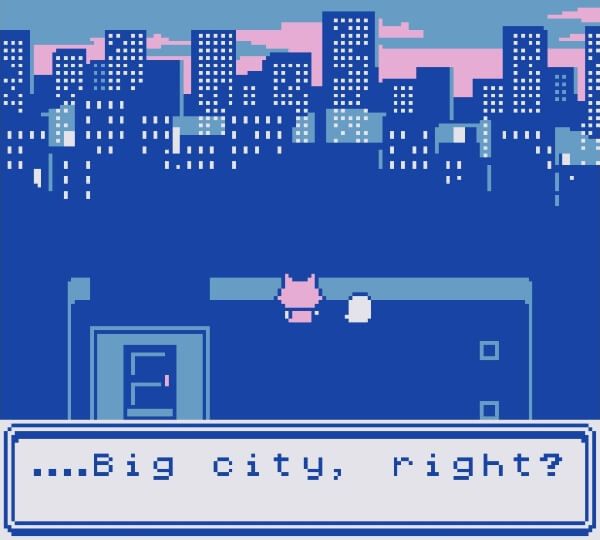🎤 Interview with Nekobungi Sumire
2023年 11月 20日
We had the opportunity to speak with Nekobungi Sumire, a manga artist who recently released the emotional and beautiful Neko Can Dream in English! We got to talk about telling queer stories in both manga and video game format, and addressing contemporary themes through retro limitations!
English

(2022) Neko Can Dream, now with English!
# Please tell us a little bit about yourself.
I am Nekobungi Sumire, a Japanese trans woman and a wife to a bisexual husband. I mainly create webcomics and doujinshi manga (one-shot comics) under the group name Amaitorte.

(2016) Alice Sherlock: The Rubious Nebula
# Can you tell us about how you started making manga, and some titles that you’ve created?
Since childhood, my fascination with storytelling and crafting original universes has been a constant. For me, manga has proven to be the most efficient medium for expressing these ideas. Unlike video production that demands extensive time and effort, and novels where I can’t visually depict my ideas, manga allows me to draw as I please.
My first manga that reached a wider audience, Alice Sherlock: The Rubious Nebula, gained some recognition not only in Japan but also internationally. Subsequently, I delved into creating doujinshi manga. Given their mostly one-shot nature and ease of translation into English, I actively release translated versions. In recent years, many of my works, including Locusta in the Skyscraper, Azami on the Tail, and Silhouette of the Sea Breeze, whose English version was recently completed, have been embraced by readers worldwide.

(2022) Locusta in the Skyscraper
# How did you get started making games?
As mentioned earlier, I opted for manga as my storytelling medium, but I’ve always harboured a desire to delve into the world of video games. However, game development is a highly intricate process, and at that time, accessible tools were hard to come by, making it a formidable challenge to bring my ideas to life. The turning point came in 2019 with the release of a tool called GB Studio. Its user-friendly controls and the ability to create 8-bit games playable on a real GB provided the motivation I needed to overcome the previous hurdles. GB was the very first game console I was allowed to play as a child, so working with GB Studio felt like a nostalgic journey back in time, realising a childhood dream. Moreover, GB Studio hadn’t yet gained much attention in Japan, and I was determined to be the first to complete a full-fledged game using it.

# Please tell us about Neko Can Dream!
I dedicated approximately three years to developing of the initial release, the Japanese edition of Neko Can Dream. It’s my first and at the moment only game project. The central character is a non-binary individual with cat ears who awakens one evening in a back alley of a bustling city, grappling with hunger and amnesia. To satiate their hunger, they grab a can of cat food, only to discover from a city resident that it’s actually an item known as a ‘dream can’. The protagonist is then tasked with making more dream cans, and the method involves venturing into the dream world of sleeping humans.
# Can you tell us about the process of making Neko Can Dream? Was it different from the way you approached making your other games?
(This is my only video game work at the moment, so I will describe how it compares to my other manga work.)
Since this marked my first foray into video game production, everything was essentially an experiment. Unlike manga creation, where I only needed to formulate the story and then sequentially illustrate it, video game development proved to be a more complex process. At the outset, I wrestled with the task of determining which elements of the story could be effectively conveyed through GB Studio. I crafted test versions for each segments, saw how they worked, and then iteratively revamped the entire narrative. This iterative process persisted as I honed and adjusted the game to materialise my vision.

# What was your greatest influence when making Neko Can Dream?
Given that this game revolves around exploring a dream world, many players might naturally draw connections to Yume Nikki, which happens to be one of my favourite games as well. However, the direct inspiration for the dream theme actually comes from the game Forget me not -Palette-. This title may not be widely recognised outside Japan, but to the best of my knowledge, it was the first game to delve into characters’ pasts through a dream world narrative.
I also must acknowledge the impact of Yorunokasou in shaping my creative approach. It’s an adventure game, also developed using GB Studio and currently in progress under the skillful hands of Yaigi-sensei, whom I deeply respect. The game is characterised by its endearing characters and an enticing setting.
# I really enjoyed the mysterious characters in the dream world and their slightly surreal dialogue. Can you tell us how you created the world of this game?
To ensure the game boasted a substantial volume, it became imperative to introduce variations in the game world, preventing player monotony. Opting for a diverse array of stages with distinct appearances and linking them to the characters’ pasts, all woven into a cohesive narrative, led me to the conventional and robust choice of structuring the game around the exploration of dream worlds. Given the stringent capacity limitations of 8-bit consoles, a practical approach was to associate one dream with one item, a can. This method proved convenient for incrementally expanding the stages while mindful of capacity left. I believe my experience in manga played a pivotal role in seamlessly integrating the individual stages into a unified storyline.

# What was it like releasing Neko Can Dream as a GameBoy cartridge?
This title is available in a mobile app version for iPhone, iPad, and Android, as well as a ROM cartridge version for the GB, complete with a box and an instruction booklet that faithfully replicates the actual products from back in the day. The aim is to provide an enjoyable experience from the moment of unboxing.
Due to the immense popularity of the Japanese edition upon its initial release, there was a temporary delay in keeping up with manufacturing demands (I am my own publisher and manufacturer, so cartridge production is hard work!). However, by the time the English edition was launched, sufficient stock was made available. If you happen to own a GB console, I would be delighted if you could choose the ROM cartridge version. Understandably, not everyone still possesses a GB console, so in that case, please enjoy the mobile app version.

# I heard that you did the English localization yourself. Can you tell us what it was like translating the game? Were there any spots that gave you trouble?
Having recently acquainted myself with the translation process during the creation of the English version of the doujinshi manga, I decided to take on the translation for the game as well. The game, being more extensive than any of my manga projects, presented a challenge in managing the substantial amount of dialogue. Ensuring consistency and coherence across numerous lines proved to be demanding. Additionally, as it is an 8-bit game, there is a constraint on the number of characters that can be displayed on the screen. This occasionally required me to carefully choose words that would fit within the screen limits.

# Is there anything in Neko Can Dream to which you want to draw the player’s attention?
In recent years, there has been a resurgence of interest in retro-style games, with many adopting 8-bit and 16-bit-like pixel graphics. However, unlike those games, this one was authentically developed in 8-bit. It may lack the visual flair of retro-style games that merely imitate 8-bit aesthetics, but I invite you to appreciate the best graphics achievable within the constraints of the actual game console. It’s worth noting that binaries designed for 8-bit processors are still operational on the latest smartphones, maintaining compatibility with game hardware from three decades ago.
Nevertheless, the creation of this game wasn’t driven by a simple nostalgia agenda, and my goal was never to resurrect the era of 30 years ago in the present day. I delve into contemporary themes, addressing issues such as the challenges faced by trans children, the lives of queer couples, and other elements that were often overlooked during the GB era. By courageously presenting this narrative in an older format, my aim is to fill in some of the missing pieces for those who didn’t always have a happy childhood back then.
# Can you tell us about anything you are currently working on?
I’ve returned to working on a feature-length webcomic, and my current project is called The Kingdom of Felismans. It’s a story that incorporates typical JRPG fantasy motifs but is set in a world with its own rich history. In this unique realm, human men have vanished due to a curse cast by a demon lord, and in their absence, felismans, cat furry beings, have emerged to rule over the human women. The main characters are a lesbian couple, and the narrative delves into themes of gender inequality, sexism, and gender dysphoria. I aspire to translate this work into English someday, so I hope you can look forward to it.

# Do you have any messages for your players?
To everyone who has become aware of my presence through this game, I hope you will now consider exploring my manga as well. Beyond my past works, I still have many ideas I want to express, so I hope you’ll keep an eye out for the upcoming projects that I’ll be announcing. Thank you very much!
# Thank you for sharing your thoughts with us!
日本語訳
日本語訳:ダイコン

# 自己紹介をお願いします
私は猫儀スミレと申します。トランス女性の日本人で、バイセクシャルの夫と暮らしています。私は主にAmaitorteというグループ名の元でウェブコミックや同人漫画(one-shot comics)を作っています。

# 漫画を描き始めたきっかけについて教えてください。また過去に作成した漫画について教えてください。
子供の頃から、ストーリーを伝えたり、オリジナルの世界を作ることに、私は常に魅力を感じていました。私にとって、漫画はこれらのアイデアを表現するのに最も効率的な媒体であることがわかりました。時間と労力がかかる映像制作や、自分のアイデアを視覚的に表現できない小説と違って、漫画は思いのままに描くことができます。
多くの読者に届けられた私の最初のマンガ「アリス・シャーロック:ルビー色の星雲」 は、日本だけでなく国際的にも一定の評価を得ました。それから、同人誌マンガの制作に本格的に取り組みました。ほぼワンショットの性質と英語への翻訳の容易さを考慮して、私は積極的に翻訳版をリリースしています。近年では 「摩天楼のロクスタ」、「アザミ・オン・ザ・テール」、最近英語版も完成した 「海風のシルエット」 など、多くの作品が世界中の読者に受け入れられています。

# ゲーム作りを始めたきっかけはなんですか。
前述のとおり、私はストーリーテリングの媒体としてマンガを選択しましたが、ビデオゲームの世界を深く掘り下げたいと常に思っていました。しかし、ゲーム開発は非常に複雑なプロセスであり、当時はアクセス可能なツールを入手するのが困難であったため、私のアイデアを実現するのは非常に困難な課題でした。転機は2019年にGB Studioと呼ばれるツールのリリースで起こりました。ユーザーフレンドリーなコントロールと、実際のGBでプレイ可能な8ビットゲームを作成できる機能が、いままでのハードルを克服する必要なモチベーションを与えてくれました。GBは私が子供の頃にプレイさせてもらった最初のゲーム機だったので、GB Studioで作業するのは、昔に戻って子供の頃の夢を実現した懐かしい旅のように感じました。また、GB Studioは日本ではまだあまり注目されていなかったので、これを使って本格的なゲームを初めて完成させたいという思いがありました。

# 「猫缶ドリーム」というゲームについて教えてください。
私は最初のリリースである「猫缶ドリーム」の日本語版の開発に約3年間を費やしました。これは私にとって現時点で唯一のゲームプロジェクトです。中心人物は猫耳のノンバイナリーの人物で、ある晩ににぎやかな街の路地裏で目覚め、飢えと記憶喪失と格闘しています。空腹を満たすためにキャットフードの缶を手に取りますが、それは街の住人から「夢の缶」といわれているアイテムであることを知りました。次に、主人公はさらに夢の缶を作るという任務を課せられ、その方法には眠っている人間の夢の世界に足を踏み入れることとなります。
# 「猫缶ドリーム」を作るときに、どのようなプロセスで作成しましたか。他のゲームを作るときと何か違いがありますか。
(現時点ではこれが唯一のビデオゲーム作品なので、他の漫画作品と比較して説明します)
これが私にとってビデオゲーム制作への初の挑戦だったので、すべては本質的に実験でした。ストーリーを組み立ててそれを順番に説明するだけで済むマンガ制作とは異なり、ビデオゲームの開発はより複雑なプロセスであることがわかりました。最初は、物語のどの要素をGB Studioで効果的に伝えるかという課題に取り組みました。各セグメントのテストバージョンを作成し、それがどのように機能するかを確認し、物語全体を繰り返し修正しました。この反復プロセスは、自分のビジョンを実現するためにゲームを磨き、調整する間も続きました。

# 「猫缶ドリーム」を作成するにあたり、最も影響を受けたものは何ですか。
このゲームが夢の世界の探索を中心に展開していることから、多くのプレイヤーは自然に「ゆめにっき」と結びつくかもしれません。これはたまたま私のお気に入りのゲームの1つでもあります。しかし、この夢のテーマの直接のインスピレーションは、実は「Forget me not -パレット-」から来ています。このタイトルは日本以外ではあまり知られていないかもしれませんが、私の知る限り、夢の世界の物語を通してキャラクターの過去を掘り下げた初めてのゲームでした。
また、私の創作アプローチの形成に「ヨルノカソウ」が与えた影響も認めなければなりません。こちらもGB Studioで開発され、尊敬するやいぎ先生により現在進行中のアドベンチャーゲームです。このゲームは、その愛らしいキャラクターと魅力的な設定が特徴です。
# 夢の世界の不思議なキャラクタやセリフの言い回しなどがとても楽しかったです。猫缶の世界をどのようにして作ったか教えてください。
ゲームがそれなりのボリュームをもつには、ゲーム世界にバリエーションを導入し、プレイヤーの単調さを防ぐことが不可欠でした。特徴的な外観の多様なステージを選び、それらをキャラクターの過去と結び付け、すべてが一貫した物語に織り込まれていることから、夢の世界の探索を中心にゲームを構築するという従来型かつ堅牢な選択になりました。8ビットコンソールの厳しい容量制限を考慮すると、現実的なアプローチは、1 つの夢を1つのアイテム(缶)に関連付けることでした。この方法は、残容量を考慮しながら段階的にステージを拡張する場合に便利であることがわかりました。私の漫画での経験は、個々のステージを統一されたストーリーラインにシームレスに統合する上で極めて重要な役割を果たしたと信じています。

# 「猫缶ドリーム」はGameBoyのカートリッジでもリリースされました。そのリリースはどうでしたか。
本作はiPhone、iPad、Androidのアプリ版とGBのROMカートリッジ版があり、当時の実物を忠実に再現した箱と説明書も付属します。開梱した瞬間から楽しい体験を提供することを目指しています。
日本語版の発売当初に非常に人気があったため、製造需要に追いつくのに一時的な遅れが生じました(私は自分で出版社兼製造業者を経営しているため、カートリッジの生産は大変な作業です!)。しかし、英語版が発売されるまでに、十分な在庫が用意されました。GB本体をお持ちの方はROMカートリッジ版をお選びいただければ幸いです。GB本体を持っている人はほとんどいないと思いますので、その場合はモバイルアプリ版をお楽しみください。

# 今回ご自身でローカライゼーションをされたと伺っております。翻訳をしてどうでしたか。何か、難しかった点などがあれば教えてください。
最近、同人誌漫画の英語版制作時の翻訳プロセスを知ったので、ゲームの翻訳もすることにしました。このゲームはどの漫画プロジェクトよりも広範囲であり、かなりの量の会話を管理することが課題でした。多数の行にわたって一貫性を確保することは、難しいことがわかりました。また、8ビットゲームのため、画面に表示できる文字数に制限があります。そのため、画面の制限内に収まる単語を慎重に選択する必要がある場合がありました。

# 「猫缶ドリーム」において、プレイヤーに伝えたいこだわったポイントなどありますか。
近年、レトロスタイルのゲームへの関心が再び高まっており、その多くは8ビットや16ビットのようなピクセルグラフィックスを採用しています。ただし、このゲームはこれらのゲームとは異なり、本格的に8ビットで開発しました。8ビットの美学を模倣したレトロスタイルゲームのビジュアルセンスには欠けるかもしれませんが、実際のゲームコンソールの制約内で達成可能な最高のグラフィックスをぜひご賞味ください。8ビットプロセッサ向けに設計されたバイナリが最新のスマートフォンでも動作し、30年前のゲームハードウェアとの互換性を維持していることは注目に値します。
しかしながら、このゲームの制作は単純な懐かしさの達成の目的ですすめたものではなく、私の目標は30年前の時代を現代に復活させることではありません。私は現代的なテーマを掘り下げ、トランスジェンダーの子供たちが直面する課題、クィアカップルの生活、GB時代には見落とされがちだったその他の要素などの問題に取り組みます。この物語を古い形式で勇気を持って提示することで、私の目的は、当時必ずしも幸せな子供時代を送れなかった人々の欠けている部分を埋めることです。
# 今はどのようなプロジェクトを進めていますか。今作っているゲームなどをもしよろしければご紹介お願いします。
私は長編ウェブコミックの制作に戻りました。現在のプロジェクトは「フェリスマンの国」という名前です。典型的なJRPGファンタジーのモチーフを組み込んだ物語ですが、独自の豊かな歴史を持つ世界が舞台です。この独特の領域では、人間の男性が魔王の呪いによって姿を消し、男性たちがいない間に、猫の毛皮に覆われた存在であるフェリスマンが人間の女性を支配するために現れました。主人公はレズビアンのカップルで、物語は男女の不平等、性差別、性別違和のテーマを掘り下げています。いつかこの作品を英訳したいと思っていますので、楽しみにしていてください。

# プレイヤーの皆さんへ何かメッセージがあれば一言お願いします。
このゲームを通じて私の存在に気づいてくださった皆様、ぜひ私の漫画にも興味を持っていただければ幸いです。過去の作品以外にも、まだまだ表現したいことがたくさんあるので、今後発表していくプロジェクトにも注目していただければと思います。どうもありがとうございます!
# この度はインタビューにご協力いただき誠にありがとうございます。

